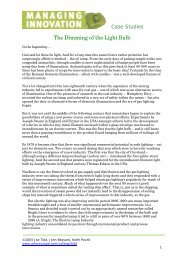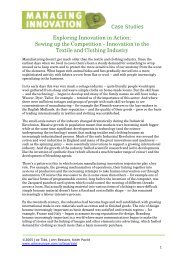Case Studies Lego - Managing Innovation
Case Studies Lego - Managing Innovation
Case Studies Lego - Managing Innovation
Create successful ePaper yourself
Turn your PDF publications into a flip-book with our unique Google optimized e-Paper software.
©2009 Joe Tidd, John Bessant<br />
www.wileyeurope.com/college/tidd<br />
<strong>Case</strong> <strong>Studies</strong><br />
apparently bricks made today can still interlock with those made in the first batch of 1958.<br />
Not surprisingly Fortune magazine named <strong>Lego</strong> as ‘toy of the century’ in 1999.<br />
However by the late 1990s the company had begun to run into difficulties. In their main<br />
product area low cost ‘good enough’ quality competition was making inroads into their<br />
market – a classic example of disruptive innovation similar to the low cost airline revolution.<br />
For example a Canadian company, Megabloks, began offering a wide range of competitively<br />
priced building toys which rapidly pushed <strong>Lego</strong> along the shelf space of many stores. At the<br />
same time a large section of their traditional market – young boys – was increasingly being<br />
drawn away from building models and into the world of computer games. And finally <strong>Lego</strong><br />
was a global company but based in a high cost economy – Denmark – with resulting pressure<br />
on its operations to remain competitive. Its supply chains were long and expensive – at one<br />
stage with 11,000 contractors <strong>Lego</strong> had more suppliers than Boeing used to build its aircraft!<br />
And its product development had become increasingly complex, with many product ranges<br />
involving such a wide range of choice – for example the Pirate figures had no less than 10<br />
different leg designs, each with its own clothing – that it became difficult to manufacture<br />
economically.<br />
The combination of these circumstances saw the company increasingly losing money and<br />
market share and the crisis peaked around 2003 with a reported loss of $240m and fears<br />
that the giant Mattel company would take over <strong>Lego</strong>. The tradition of hands on family<br />
management ended with the stepping down of 3 rd generation Kjeld Kirk Christiansen and the<br />
appointment of a new CEO appointed, Jorgen Vig Knudstorp. His arrival, plus the injection<br />
of $178million from the family, allowed a breathing space within which a turnaround could<br />
be effected. The transition – although painful – seems to have worked with the company<br />
back in profitability by 2006 and in 2007 turning in its best-ever financial performance. It<br />
involved extensive rationalization and cost-cutting in areas like supply chain and factory<br />
location, together with a rethink of the product development strategy. For example the<br />
number of unique pieces being manufactured in Billund was cut from 12,400 to around<br />
7,000. But it also included extensive learning about new ways of working with users as<br />
designers as part of the product innovation approach.<br />
Rethinking the role of users<br />
Users have always been involved in the <strong>Lego</strong> concept since – as we saw earlier – the potential<br />
configuration of even a small number of bricks is huge. People might buy a <strong>Lego</strong> toy to make<br />
a car or house but will quickly adapt it and reassemble the bricks in all sorts of different –<br />
and user created – ways. But since 2000 <strong>Lego</strong> has been on a journey which puts this userlinked<br />
approach increasingly at the centre of their strategy.<br />
Early work behind the scenes in improving production efficiency involved building digital<br />
models of all the bricks and other components which they made. By having such models it<br />
became possible to explore new product options via computer-aided design and to link this<br />
to computer-aided manufacturing, helping reduce overall time and cost in manufacturing.<br />
But this also opened up an interesting product option in the market-place – customizable<br />
toys. An early product was called <strong>Lego</strong> Mosaic, originally launched in 2000, which allowed<br />
users to upload photographs to the company’s website. <strong>Lego</strong> would digitize the picture and<br />
calculate the bricks required to make a wall-hanging mosaic with multiple colours.<br />
Mosaic provided an early learning experience which has fed through to an increasing variety<br />
of user configurable products in which users can modify or even design from scratch their<br />
2




